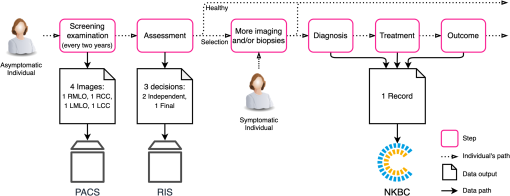2023-03-20 カロリンスカ研究所(KI)
このプラットフォームを使用することで、他の種類のがんにも適用できる同様のプラットフォームを開発することが可能になります。プラットフォームには、同じ画像を処理するすべてのアルゴリズムが含まれ、実際のがん診断データと比較されます。また、製造業者にとっても独立した評価となるため、自社製品を改善することが期待されます。
<関連情報>
- https://news.ki.se/now-local-hospitals-can-determine-how-ai-systems-would-detect-breast-cancer
- https://www.spiedigitallibrary.org/journals/journal-of-medical-imaging/volume-10/issue-06/061404/VAI-B–a-multicenter-platform-for-the-external-validation/10.1117/1.JMI.10.6.061404.full
VAI-B:乳房画像診断における人工知能アルゴリズムの外部検証のための多施設プラットフォーム VAI-B: a multicenter platform for the external validation of artificial intelligence algorithms in breast imaging
Fernando Cossío, Haiko Schurz, Mathias Engström, Carl Barck-Holst, Apostolia Tsirikoglou, Claes Lundström, Håkan Gustafsson, Kevin Smith, Sophia Zackrisson, Fredrik Strand
Journal of Medical Imaging Published:20 March 2023
DOI:https://doi.org/10.1117/1.JMI.10.6.061404

Abstract
Purpose
Multiple vendors are currently offering artificial intelligence (AI) computer-aided systems for triage detection, diagnosis, and risk prediction of breast cancer based on screening mammography. There is an imminent need to establish validation platforms that enable fair and transparent testing of these systems against external data.
Approach
We developed validation of artificial intelligence for breast imaging (VAI-B), a platform for independent validation of AI algorithms in breast imaging. The platform is a hybrid solution, with one part implemented in the cloud and another in an on-premises environment at Karolinska Institute. Cloud services provide the flexibility of scaling the computing power during inference time, while secure on-premises clinical data storage preserves their privacy. A MongoDB database and a python package were developed to store and manage the data on-premises. VAI-B requires four data components: radiological images, AI inferences, radiologist assessments, and cancer outcomes.
Results
To pilot test VAI-B, we defined a case-control population based on 8080 patients diagnosed with breast cancer and 36,339 healthy women based on the Swedish national quality registry for breast cancer. Images and radiological assessments from more than 100,000 mammography examinations were extracted from hospitals in three regions of Sweden. The images were processed by AI systems from three vendors in a virtual private cloud to produce abnormality scores related to signs of cancer in the images. A total of 105,706 examinations have been processed and stored in the database.
Conclusions
We have created a platform that will allow downstream evaluation of AI systems for breast cancer detection, which enables faster development cycles for participating vendors and safer AI adoption for participating hospitals. The platform was designed to be scalable and ready to be expanded should a new vendor want to evaluate their system or should a new hospital wish to obtain an evaluation of different AI systems on their images.


